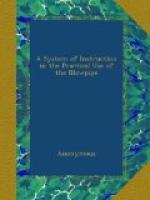[Illustration: Fig. 6]
This lamp is generally resorted to by blowpipe analysts, for the purpose of experiments in glass apparatus, as the oily combustibles will coat the glass with soot. Some substances, when exposed to the dark part of the flame, become reduced and, in statu nascendi, evaporated; but by passing through the external part of the flame, they become oxidized again, and impart a color to the flame. The spirit flame is the most efficient one for the examination of substances the nature of which we wish to ascertain through color imparted to the flame, as that of the spirit-lamp being colorless, is, consequently, most easily and thoroughly recognized by the slightest tinge imparted to it.
It is necessary that in operating with such minute quantities of substances as are used in blowpipe analysis, that they should have some appropriate support. In order that no false results may ensue, it is necessary that the supports should be of such a nature that they will not form a chemical combination with the substance while it is exposed to fusion or ignition. Appropriate supports for the different blowpipe experiments are charcoal, platinum instruments, and glass tubes.
(a.) Charcoal.—The value of charcoal as a support may be stated as follows:
1. The charcoal is infusible,
and being a poor conductor of
heat, a substance can be exposed
to a higher degree of heat
upon it than upon any other
substance.
2. It is very porous, and therefore allows easily fusible substances (such as alkalies and fluxes) to pass into it, while other substances less fusible, such as metals, to remain unabsorbed.
3. It has likewise a great reducing power.
The best kind of charcoal is that of pinewood, linden, willow, or alderwood, or any other soft wood. Coal from the firwood sparkles too freely, while that of the hard woods contains too much iron in its ashes. Smooth pieces, free from bark and knots, should be selected. It should be thoroughly burnt, and the annual rings or growths should be as close together as possible.
If the charcoal is in masses, it should be sawed into pieces about six inches in length by about two inches broad, but so that the year-growths run perpendicular to the broadest side, as the other sides, by their unequal structure, burn unevenly.
That the substance under examination may not be carried off by the blast, small conical concavities should be cut in the broad side of the charcoal, between the year-growths, with a conical tube of tin plate about two or three inches long, and one quarter of an inch at one end, and half an inch at the other. These edges are made sharp with a file. The widest end of this charcoal borer is used for the purpose of making cavities for cupellation.
In places where the proper kind of charcoal is difficult to procure, it is economical to cut common charcoal into pieces about an inch broad, and the third of an inch thick. In each of these little pieces small cavities should be cut with the small end of the borer. When these pieces of charcoal are required for use, they must be fastened to a narrow slip of tin plate, one end of which is bent into the form of a hook, under which the plate of charcoal is pushed.




